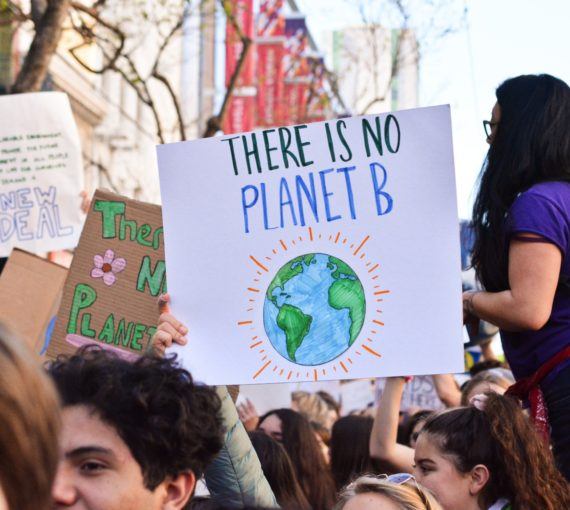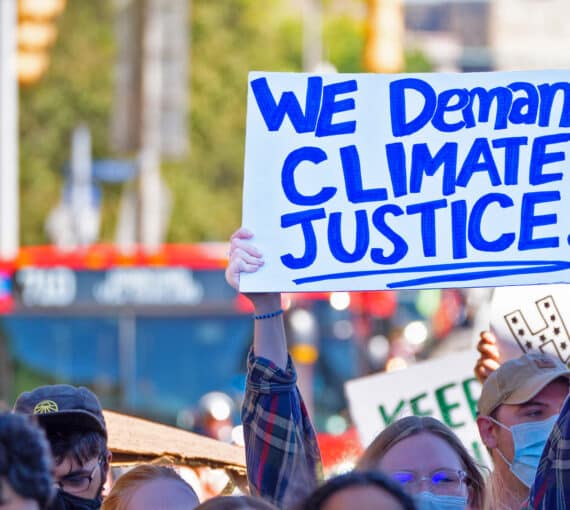
The majority of SUV owners aren’t using them to explore nature — especially not in the benign way advertising promises. (Photo: Adam Bixby via Unsplash)
You’ve probably seen the ads: people in sport utility vehicles and trucks escaping the noise and chaos of the city to explore pristine wilderness. These vehicles buy freedom, and get you closer to nature!
The ads are everywhere — because they work. A U.K. study found advertising significantly increased demand for the polluting vehicles while drowning out messaging encouraging people to choose “greener” options such as cycling and public transit. While global car sales dropped slightly in 2022, SUV sales increased, as they have for years. The International Energy Agency reports that SUVs made up 46 per cent of global car sales in 2022.
A 2021 Équiterre study found that the automobile industry is Canada’s top advertiser, accounting for 21 per cent of total digital advertising investment in 2018 — much of it for “light-duty” trucks, including SUVs, crossover utility vehicles, pickup trucks and minivans. David Suzuki Foundation research found that in 2020 and 2021, 80 per cent of new vehicle sales in Canada were light-duty trucks, compared to 54 per cent in 2010.
The majority of SUV owners aren’t using them to explore nature — especially not in the benign way advertising promises.
“From 1990 to 2018 in Canada, the number of cars on the road went up by 10 per cent, while the number of light-duty trucks went up by a factor of three (from 3.4 million to 13 million),” the Foundation found.
The majority of SUV owners aren’t using them to explore nature — especially not in the benign way advertising promises. Most are driving to work or shopping, stuck in a gridlock of other vehicles inefficiently transporting individuals in massive, polluting — and unsafe — machines.
Light-duty trucks such as SUVs contribute significantly to rising greenhouse gas emissions. According to the IEA, although oil use in conventional cars remained roughly the same between 2021 and 2022, global SUV oil consumption rose by 500,000 barrels a day, “accounting for one-third of the total growth in oil demand.”
SUVs consume 20 per cent more oil than an average medium-size car, the IEA reports, and “combustion-related CO2 emissions of SUVs increased by nearly 70 million tonnes in 2022. Altogether, the 330 million SUVs on the road today emit nearly 1 billion tonnes of CO2.”
Larger vehicles also drive up taxpayer costs by creating more wear and tear on roads and infrastructure, and increase urban congestion because of their size.
Gas-fuelled SUVs also pollute air, water and soil with their emissions and “tire wear particles,” affecting humans, fish and other organisms. And, while many people buy them because they think they’re safer, they’re larger, heavier and offer poorer visibility than conventional cars, making roads more dangerous for everyone.
The Foundation’s research found SUV drivers often prioritized their own safety regarding accidents and weather conditions but showed little concern for known impacts on pedestrians, cyclists, drivers and passengers in other vehicles. SUVs and trucks also harm increasing numbers of wildlife. Vehicles kill more than 350 million vertebrates a year in the United States alone.
Using SUVs and trucks as the advertising depicts — such as off-roading through stream beds or forests — destroys habitat. And SUVs are more expensive and contribute more to household debt than conventional cars — which themselves cost far more than alternatives such as public transport and active transportation like cycling and walking. Larger vehicles also drive up taxpayer costs by creating more wear and tear on roads and infrastructure, and increase urban congestion because of their size.
The answer is to leave behind the strange notion that every person should have tonnes of metal and materials to move them around. We need better options, including improved public and active transportation.
Although electric vehicles made up 16 per cent of global SUV sales in 2022, they’re not the solution. Electric trucks are more efficient and emit less pollution and greenhouse gases than gas-powered, but they’re heavier, thanks to battery weight, making them more dangerous. Mining for minerals the batteries require is not as destructive as oil extraction and production, but it’s a serious problem — especially for larger vehicles that use more minerals.
The answer is to leave behind the strange notion that every person should have tonnes of metal and materials to move them around. We need better options, including improved public and active transportation.
Many governments have banned advertising for cigarettes and other destructive products. Let’s also ban advertising for these behemoths and all gas-fuelled vehicles.
Gas-guzzling vehicles have long been part of the push to sell lots of cheap fossil fuels, making the oil industry the most profitable in history. Changing the way we get around is one of the best ways to combat pollution and climate change. Advertising for trucks and SUVs is a roadblock to progress.



